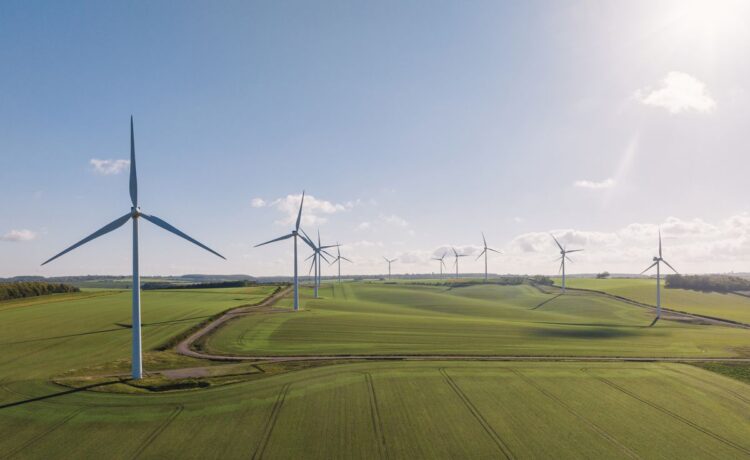The government has promised to make Britain into a “clean energy superpower” by 2030. The UK’s share of electricity generation from renewables currently stands at 46%, according to the government’s own statistics, and the pledge calls for at least 95% to come from low-carbon sources. Getting there will involve doubling onshore wind to 35GW, tripling solar power to 50GW and quadrupling offshore wind to 55GW.
This will also require significant investment in storage and distribution. Last year National Grid, the network operator, raised £6.8 billion in a rights issue as part of plans to invest £23 billion over the next four years upgrading its transmission network to support the transition to renewables. Meanwhile, the 138-page Action Plan that UK Department for Energy Security and Net Zero (DESNZ) published in December says 29GW-35GW of batteries will be required by 2030, compared with less than 5GW installed today.
All told, this adds up to a lot of investment: if the targets are to be met, it implies that £40 billion per year is needed between now and 2030. Therein lies the problem: where will that come from? With the government’s own borrowing constrained by nervy global bond markets, it is unclear who is going to step up to fund these clean energy aspirations.
Sign up to Money Morning
Don’t miss the latest investment and personal finances news, market analysis, plus money-saving tips with our free twice-daily newsletter
Don’t miss the latest investment and personal finances news, market analysis, plus money-saving tips with our free twice-daily newsletter
A significant amount of the renewables capacity that the UK has already built was funded by the stock market, amid a multi-year burst of enthusiasm for investing in green energy. In 2021 alone, there were nine initial public offerings (IPOs) of renewables investment vehicles that raised over £10 billion, according to Hardman & Co, the sponsored equity research boutique. Yet this boom has since turned to bust.
The entire market capitalisation of the 20 renewable energy infrastructure funds (REIFs) listed in the UK has now fallen to just £10 billion. Over the last two years, existing investors have seen a terrible return on their capital, and hardly any new money has been raised as markets have questioned the economics of the REIFs.
At the end of January, the average discount to net asset value (NAV) had slumped to 42%, according to data from ShareScope. The best of a bad bunch has been the Greencoat UK Wind, whose share price was “just” 20% below NAV. The worst performing was HydrogenOne Capital Growth on an eye-watering 74% discount (its cornerstone investors included Jim Ratcliffe and his chemicals giant Ineos).
Bond yields are only part of the problem
Some of this poor performance has been driven by fair-value accounting, which requires NAV to be marked down when the “risk-free rate” – effectively the ten-year UK government bond yield – has risen. An irony of fair-value accounting is that rising bond yields, caused in no small part by rising energy prices a couple of years ago, have discouraged investment in renewables. That’s a shame, since more investment should have lowered energy costs and improved the country’s trade deficit.
To be fair, rising government bond yields have also led to wider discounts to NAV across other investment trusts with illiquid holdings that are hard to value, not just the REIFs. Many private-equity investment trusts trade on much wider discounts than before: HarbourVest Global Private Equity has been as wide as 40%.
However, rising bond yields don’t explain why the REIF sector has seen dividend cuts and now trades on an average dividend yield above 10%. This looks like distressed valuations given the UK government bond yield of 4.5%. Meanwhile, the stock market is now valuing some REIF assets at below the build cost of new projects. Harmony Energy Income Trust (LSE: HEIT), a battery energy storage system (BESS) investor, reckons that new capacity costs £842,000 per MW. That compares with the £616,000 per MW that Harmony’s market value implies for its existing assets, so in response, it is in the process of trying to selling off its entire portfolio to realise value.
To understand what’s going on, it’s worth looking back to the TMT infrastructure bubble of the late 1990s. Strategy and management expert Richard Rumelt has pointed out that a terrible industry for shareholders will tend to have certain characteristics: i) a product that’s an undifferentiated commodity; ii) everyone has access to the same technology; iii) buyers are price sensitive and willing to switch suppliers at a moment’s notice to get a better deal; and iv) large sunk capital costs, but low marginal costs so that old capacity will continue to operate. He uses the example of Global Crossing and other fibre-optic cable firms, which failed spectacularly over 20 years ago as it became clear that it had over-invested in capacity and revenue collapsed. We can see similarities with the UK-listed REIFs, where demand is growing but has been outpaced by the supply of new capacity.
What does it mean for battery funds?
This was not how the story was supposed to play out. When Russia invaded Ukraine and the price of gas spiked in 2022, the REIFs enjoyed a strong tailwind. Combined cycle gas turbine (CCGT) generation became less competitive. Unlike renewables, which have a high upfront capital cost but low marginal cost (wind and sunshine are free), most of CCGT’s operating costs are the gas that is burnt to generate power. However, the challenge with renewables is that they are intermittent. Sometimes the grid can’t cope with excess power at the wrong time (early hours of the morning for wind, midday for solar). At these times, renewable assets may need to be curtailed – that is, paid to be turned off.
The BESS sector provides a good case study for the problems. These giant batteries store excess power for a short period of time, which provides grid stabilisation and flexibility. Initially, they benefited. Yet as the price of natural gas returned to its long-term average, National Grid went back to relying on natural gas to balance demand. Thus energy storage funds such as Gresham House Energy Storage (LSE: GRID), Gore Street Energy Storage (LSE: GSF) and HEIT have seen their share prices fall precipitously since the start of 2023. The ancillary services market, which provides short-term support, saw too much capacity for recent supply. Then in a nasty profit warning in February 2024, GRID complained that battery storage was being significantly underutilised in the National Grid Electricity System Operator’s Balancing Mechanism (BM). Excessive use of legacy gas-fired generation, which provides flexibility, resulted in oversupply in the wholesale market, reducing the revenue opportunity for BESS, which was unable to compete head-to-head with gas-fired generation. So BESS capacity went unseen in National Grid’s control room and unused.
Using Rumelt’s framework, battery funds were generating a commodity product (electricity) for a customer (National Grid) who was not only prepared to switch at a moment’s notice to a different energy supplier (gas) but was also unaware of available capacity from BESS. This hit the energy-storage funds particularly hard and they have had to cut dividends.
The problems with ancillary services and BM seem fixable: these are a result of market failure, which, contrary to government policy, has created an incentive for burning gas over battery technology. The broader question is whether the government can now create an incentive for investors to provide anything close to £40 billion for investment. For instance, if BESS has already struggled with overcapacity, then it stands to reason that as more MW of battery storage is added to the grid, returns could continue to disappoint. Note too that REIFs will struggle to raise more equity from investors as shareholders question the deep discounts to fair-value NAV. From that perspective, deciding to sell down assets may make more sense for some of them than investing in new, and possibly loss-making, capacity. Many REIFs are now facing continuation votes, so management may come under pressure to liquidate their entire portfolios.
Still, this could be an opportunity. As investment in new projects slows, existing capacity could see more favourable pricing. Perhaps this signals that the worst is over for BESS funds such as GRID, GSF and HEIT, or the whole REIF sector. That said, improving returns for shareholders may well come at the cost of the government failing to achieve its ambitious targets.
Is the worst over for GRID?
Gresham House Energy Storage Fund came to market in 2018, aiming to profit from the increased need for energy storage to support intermittent renewable energy generation. Operational capacity has since increased from 70MW seven years ago to around 1GW at the end of 2024.
After Russia invaded Ukraine in 2022 and gas prices doubled, GRID’s annualised monthly revenues peaked at around £210,000 per MW. It raised £150 million of equity in May 2022 and a further £80 million in May 2023. Since then revenues have collapsed by 80%, to around £30,000 per MW at the beginning of 2024. To fund ongoing construction of new capacity in such a difficult environment, the fund’s net cash of £222 million in June 2022 has swung to net debt of £140 million September 2024. That equates to 60% of the current market cap of £240 million, which of course is barely above the amount of money raised in 2022 and 2023. That’s why GRID has had to suspend its dividend, focused on cash preservation and renegotiate its debt covenants.
The expected lifespan of a battery is ten to 15 years, yet this depends on usage: both the passage of time and the number of charging and discharging cycles determine a battery’s longevity. However, GRID is now having to invest to replace its shorter-duration batteries with two-hour ones. The business case for four-hour batteries is starting to make sense, so we could see yet another round of investment required.
There’s also the risk of new technologies, such as ceramic-oxide batteries, making the lithium-ion assets that all the UK BESS funds use obsolete. This field moves fast: in France, ProLogium is building a huge 48GWh solid-state battery factory at cost of €5.2bn. Hydrogen fuel cells, developed by companies such as Ceres Power, may also play a role in reducing the strain on the grid from intermittent renewables supply.
In November last year, the management of GRID set out a three-year plan that assumes revenue of £45,000 per MW per year for uncontracted projects, in line with revenue conditions at the time. GRID is targeting £150 million of earnings before interest, tax depreciation and amortisation (Ebitda) in three years’ time, implying an enterprise value (EV) of just 2.5 times Ebitda. Then in a January trading statement, management said that revenue on uncontracted assets (504MW) had improved to £60,000 per MW in H2 2024. So it could be past the worst.
GRID has also signed a tolling agreement with Octopus Energy on 568MW (around half of its capacity), which should provide contracted, fixed-price, inflation-linked revenues. Interestingly, Gore Street said in its first-half results that it would not enter into tolling agreements given the prices observed, and suggested decisions to do so were driven by pressure from lenders that prefer to see steady revenue generation. Cycling rates are typically higher with tolling agreements, so can degrade the battery assets faster than otherwise would be the case. So the two biggest funds are taking different approaches.
GRID’s NAV stood at £621 million or 109p per share at the end of September, with operational assets valued at an average of £661,000 per MW. With the share price at 42p and the discount at huge 63% of NAV, management has recognised that investors are sceptical about fair-value accounting NAV. In response, GRID intends to improve disclosure so that investors can better assess cash flows and valuations. It also said recently that it would shift to levying fees on a mix of NAV and market value, rather than just NAV – a growing trend among funds that trade at a large discount.
This article was first published in MoneyWeek’s magazine. Enjoy exclusive early access to news, opinion and analysis from our team of financial experts with a MoneyWeek subscription.

















